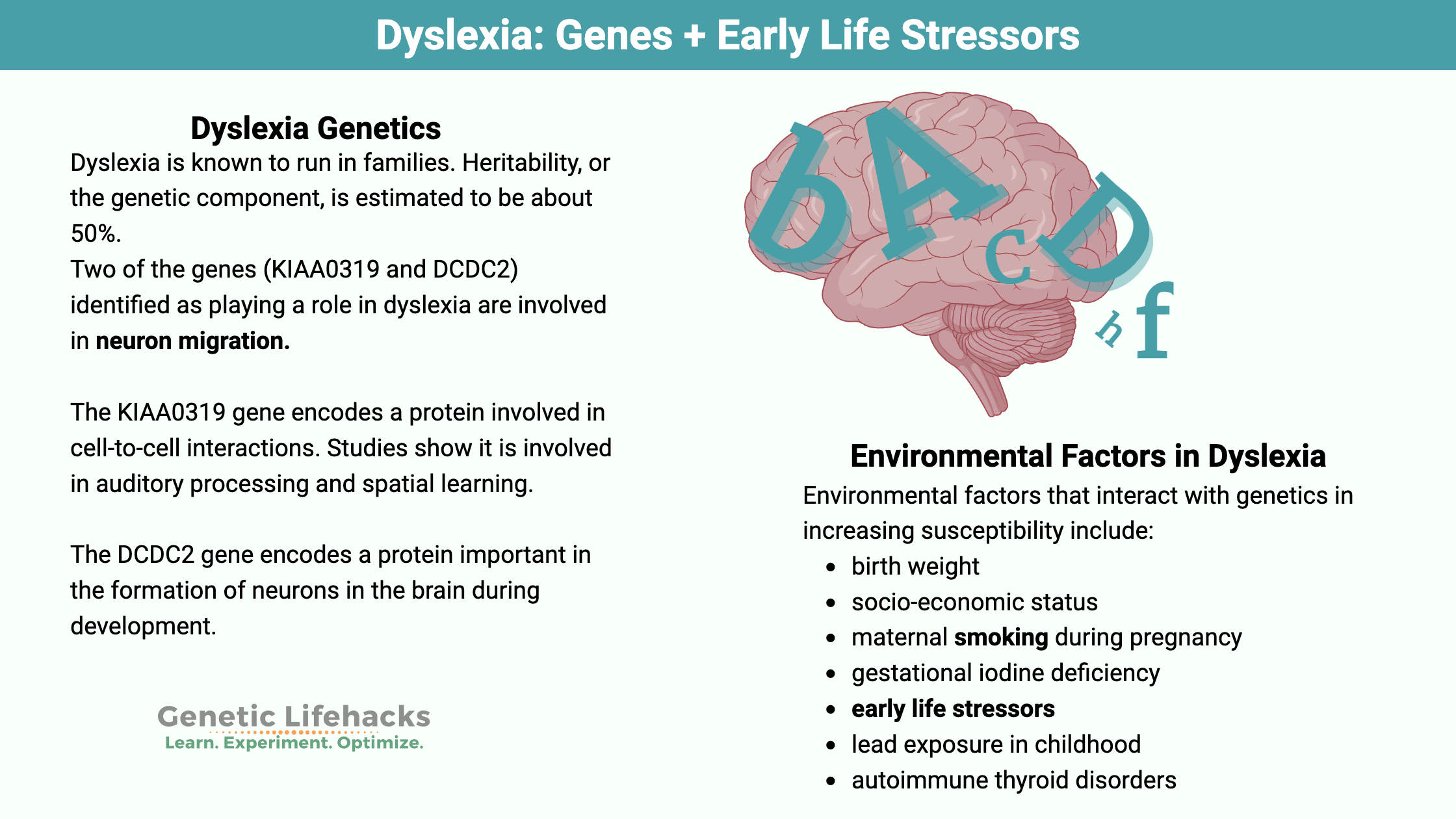Key takeaways:
~Dyslexia is a learning disorder that causes difficulty in reading or interpreting words. Children with dyslexia have problems relating speech sounds to letters.
~ Genetics research shows that changes in how neurons migrate in the brain are linked to dyslexia.
~ Early life stressors may combine with genetic variants to increase the risk of dyslexia.
This article digs into what researchers have learned about dyslexia by examining the genes that are likely to be altered in kids with dyslexia.
Members will see their genotype report below, plus additional solutions in the Lifehacks section. Consider joining today.
Is Dyslexia Genetic?
Dyslexia is known to run in families. Heritability, or the genetic component, is estimated to be about 50%.
This means that genetics plays a big role in susceptibility to dyslexia but that there are also other factors involved. Researchers have found many different genetic variants that add a little to the risk of being dyslexic, showing that dyslexia is influenced by multiple genes instead of just one ‘dyslexia gene’.
Researchers estimate that 5 – 12% of individuals are affected by dyslexia. It is diagnosed in childhood and mainly occurs in children with normal or above-average IQ.[ref]
What is going on in the brain with dyslexia?
Genetic studies can help to point to the physiological cause of dyslexia. Two of the genes (KIAA0319 and DCDC2) identified as playing a role in dyslexia are involved in neuron migration. A recent study (Oct. 2016) points to a connection between these genes and cilia, hair-like structures that are present in most neurons.[ref]
In other words, physical changes in the neurons happen in some people with the identified genetic variants. Not everyone with the variants will end up having dyslexia, though. Instead, it is a risk factor that seems to need another component.
It isn’t all genetics… environmental factors matter too.
A recent study looked at the interactions between genetics and environment in children with dyslexia combined with ADHD. The study found that one of the DCDC2 gene variants is associated with dyslexia and ADHD. Environmental factors also came into play: smoking in the home added to the correlation.[ref]
Other environmental factors that interact with genetics in increasing susceptibility may include:[ref][ref][ref]
- birth weight
- socio-economic status
- maternal smoking during pregnancy
- gestational iodine deficiency
- early life stressors
Note that all of those environmental factors cause stress, either physical or mental, in the baby or child.
Stress and the cortico-limbic system
Recent research points to the important role of chronic early-life stress on dyslexia. The brain has a vast potential to change and respond to environmental circumstances. These changes can occur in utero – but the brain is capable of changing throughout life. The biggest times of brain growth are early childhood years.
Stress – whether physical or mental – causes physiological changes. Hormones, including cortisol, can release due to stressors and affect the brain. The Hypothalamic-Pituitary-Adrenal (HPA) axis is the pathway linking stress hormones released from the adrenals and their effects on the brain.[ref]
Researchers hypothesize that early life stress causes physiological changes in the brain. In children with certain KIAA03190 genetic variants, maternal stress during pregnancy was linked with significantly poorer reading ability.[ref]
Not all stress is bad, of course. At a moderate level and intermittent, stress increases attention, motivation, and neuronal synaptic plasticity. However, chronic or excessive stress causes cellular metabolic changes that could shift the brain from growth and plasticity toward stress protection.[ref]
Dyslexia Genotype Report:
Please note that most of these SNPs are not found in 23andMe v5 data, so if you aren’t seeing your data below, that may be the reason.
Members: Log in to see your data below.
Not a member? Join here.
Why is this section is now only for members? Here’s why…
Lifehacks:
Check thyroid TPO-antibodies:
A recent study found that children with dyslexia were significantly more likely to have autoimmune thyroid issues than the normal control group.[ref]
Related article: Thyroid genes
Get the lead out:
Boys with elevated blood levels of lead have a pronounced ‘negative impact on executive function’. This wasn’t true, though, for girls.[ref]
Related Articles and Topics:
Genetics and Anxiety
Did you know that about 1 in 5 people will deal with an anxiety disorder at some point in life? From generalized anxiety to separation anxiety to panic disorder – there are underlying physiological and genetic factors involved.
GABA: Genetic variants that impact this inhibitory neurotransmitter
GABA (gamma-Aminobuyteric acid) is a neurotransmitter that acts to block or inhibit a neuron from firing. It is an essential way that the brain regulates impulses, and low GABA levels are linked with several conditions, including anxiety and PTSD.
ABCC11 gene: Ear wax and no body odor
The ABCC11 gene determines both the type of earwax a person has and whether they have no armpit or body odor.
Genetics and Double Eyelashes
Ever wonder why Elizabeth Taylor had such compelling eyes? It turns out that she probably carried a mutation for doubled eyelashes, also known as distichiasis.

